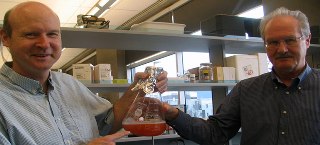Feb 23 2015
UBC microbiologist J. Thomas Beatty, bioengineer John Madden and chemist Curtis Berlinguette are working across disciplines to develop a new generation of solar cells. Their inspiration? Mother nature.
 J. Thomas Beatty and John Madden’s research partnership stretches back a decade. Source: UBC Science
J. Thomas Beatty and John Madden’s research partnership stretches back a decade. Source: UBC Science
It looked like a battery to him.
What J. Thomas Beatty was studying was a protein, but the more he thought about it the more he realized that photosynthesis proteins could behave like batteries. They do have, after all, negative and positive charges on opposing sides. But Beatty, a microbiologist, didn’t understand electrical circuits. If he was going to put his bio-battery idea to the test, he needed help.
Beatty reached out to colleagues at UBC’s Faculty of Applied Science, looking for someone with the expertise he needed. That’s how he met John Madden, a bioengineer at the multidisciplinary Advanced Materials and Process Engineering Laboratory who developed artificial muscles and organic electronics. Madden was interested in the idea of a bio-battery. They began a partnership that has lasted for a decade.
Today, Beatty and Madden are working on their second version of a solar cell inspired by the photosynthetic reactions of microorganisms.
A different angle
The current crop of solar cells on the market are not very efficient. They don’t perform well at capturing low-angle light, which means that in the morning or evening or at latitudes far from the equator, they struggle to generate power. Commercial solar cells convert sunlight into electricity with an efficiency of only 10 percent to 25 percent.
Plants, however, have no trouble capturing the energy they need from the sun. Pigment molecules in plant cells absorb a wide range of solar wavelengths, allowing photons to focus into proteins called reaction centers (RCs) with great efficiency.
Beatty and Madden are trying to mimic that process, using engineered versions of natural proteins to harvest and store solar energy.
In 2012, the pair patented a device with the capacity to generate and store solar power within a single cell. The bio-photovoltaic (bio-PV) device was fabricated using materials obtained from the photosynthetic bacterium Rhodobacter sphaeroides. By coating the surface of a carbon electrode with a layer of this genetically modified protein, the scientists are able to generate energy through an electrochemical process.
“A cell that can both harvest and store energy provides a very low-cost energy solution,” says Beatty.
Their newest battery is more efficient, though it utilizes some inorganic components. Beatty and Madden hope this second generation battery can be commercialized, but their ultimate goal is a fully organic solar battery.
To dye for
Curtis Berlinguette isn’t investigating bio-batteries—his focus is on the improved dye-sensitized solar cells, a thin film solar cell which is semi-flexible.
“What we do is coat a substrate, say your window, with titanium,” says Berlinguette “Titanium is dirt cheap, it’s the white component that is in your toothpaste so it’s environmentally benign. The problem is titanium is white or translucent so it’s not a good solar harvesting material.”
Something New Under the Sun
At Berlinguette’s lab researchers engineer dyes that have intense colours. The dyes stick to the titanium paste allowing for better sunlight absorption.
Future visions
In a desert, like Arizona, it is relatively easy to install solar farms. There is space to lay down the large panels and the sun shines constantly over them. But cities like Vancouver offer neither the space nor the best weather conditions for traditional solar farms. There’s potential, though, to use the numerous skyscrapers dotting the downtown peninsula to generate solar power.
“The types of solar cells we’re working on don’t require a reflective back layer, so we can start to incorporate these into windows,” Berlinguette explains. “If you’re going to have a window anyway we’ll coat it with our titanium and dyes, and you can generate electricity. There’s a great opportunity in urban markets to utilize this kind of technology.”
Beatty and Madden picture multiple applications for their solar batteries. Because their batteries have built-in storage capacity, they could be shipped ready-made to remote regions that currently use diesel to meet energy needs.